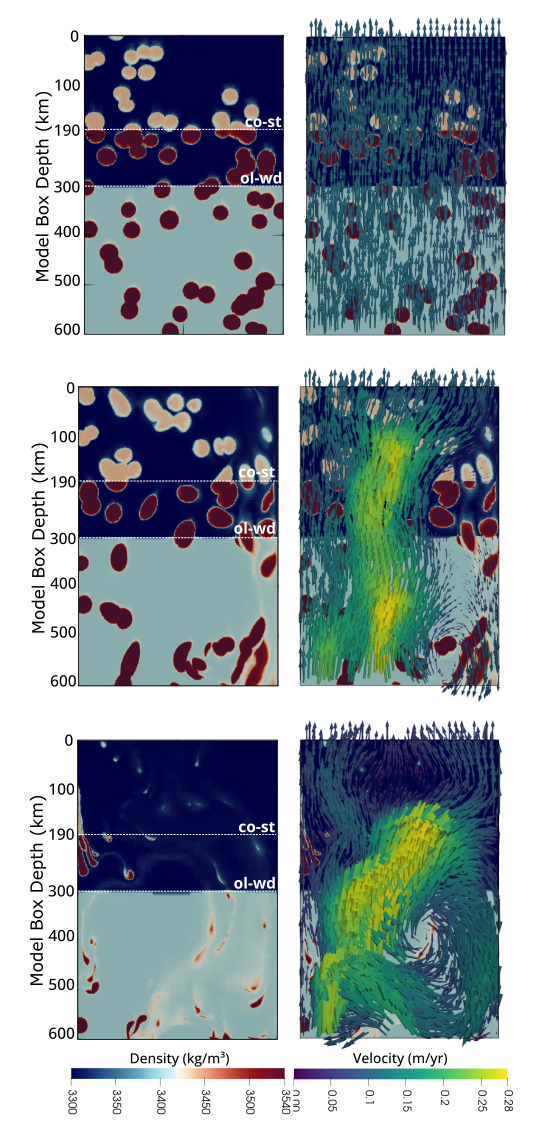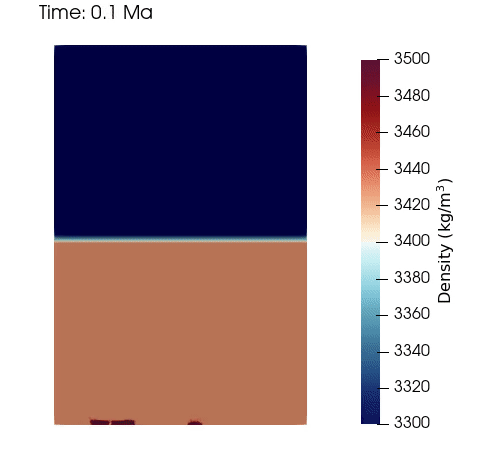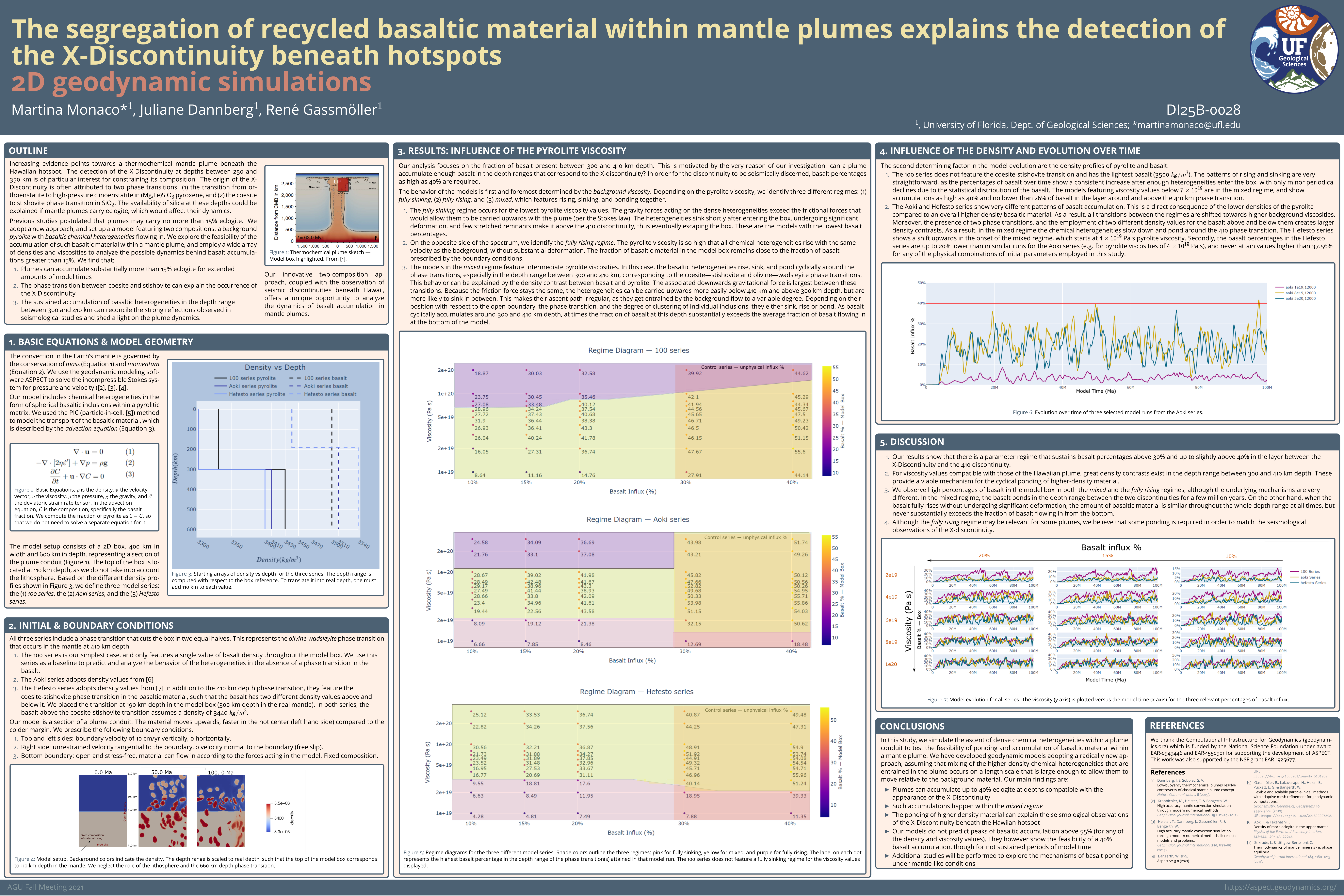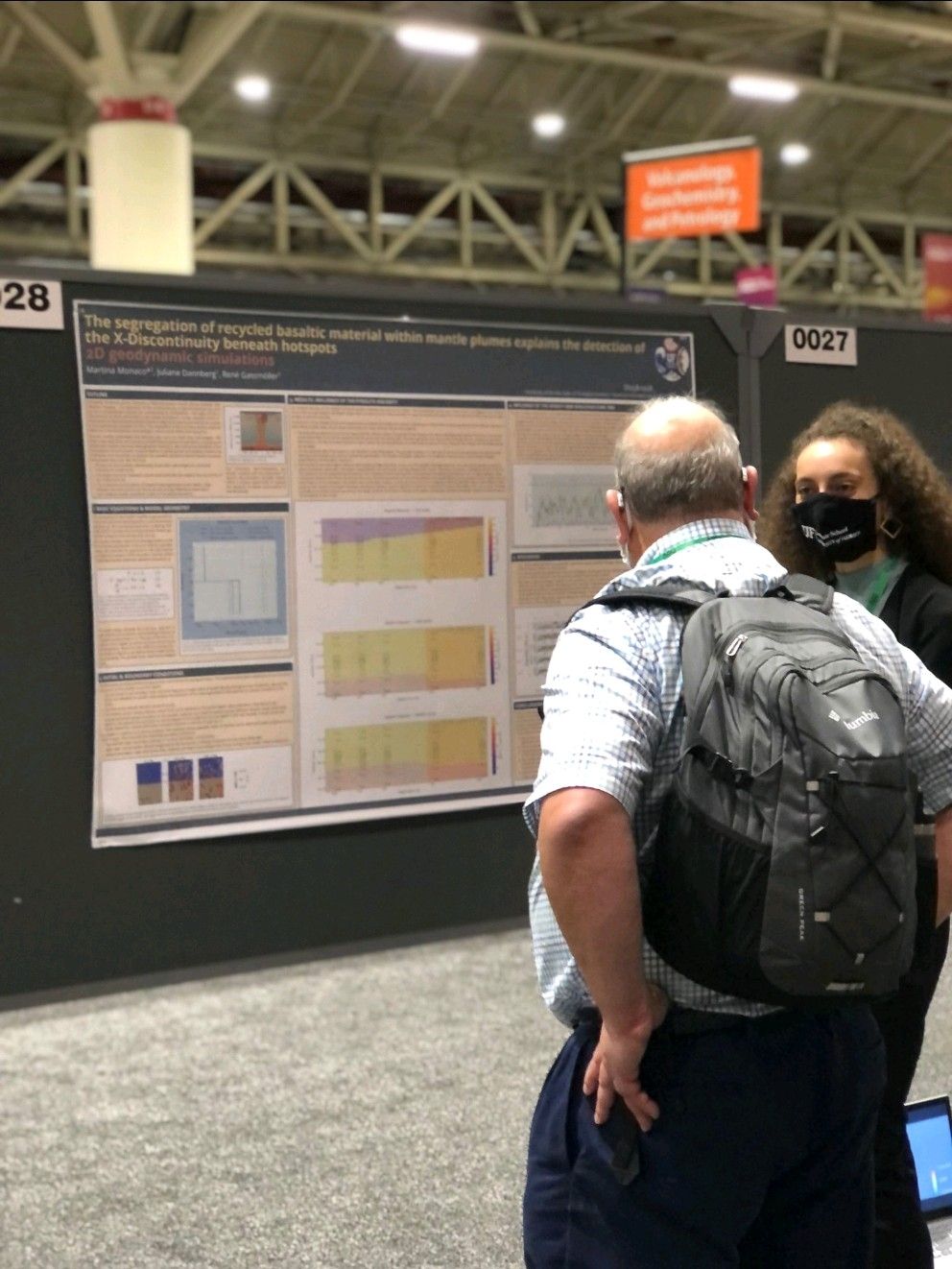Linking Geodynamic Models of Basalt Segregation in Mantle Plumes to the X-Discontinuity Observed Beneath Hotspots
¹ University of Florida, Gainesville, US
² University of Cambridge, UK
Cite the peer-reviewed version as: doi.org/10.1029/2022JB025036 or read the open-access version below.
View on JGR Solid Earth
View the open-access version
View supplementary data package

AGU Fall Meeting 2022 — Abstract
Recycled basaltic material in mantle plumes explains the appearance of the X-discontinuity in theupper mantle beneath the Hawaiian hotspot: 2D geodynamic numerical models
Martina Monaco¹, Juliane Dannberg¹, Rene Gassmöller¹, Stephen Pugh²
¹ University of Florida, Gainesville, US
² University of Cambridge, UK
Mantle plumes have a widely known role in recycling materials, but the quantities of the latter are not well constrained. Important indications come from seismic discontinuities like the X-discontinuity, interpreted as the coesite—stishovite phase transition, and clearly detected around 300 km depth beneath the Hawaiian hotspot. Seismology indicates that, for the X-discontinuity to be observed, 40% or more eclogite needs to be present. However, classical geodynamics studies predict that plumes can only carry up to 15-20% denser basalt to the surface. To resolve this controversy, we run two sets of 2D geodynamics numerical models.
Our first series features the recycled material in the plume conduit as discrete heterogeneities with diameters of 30-40 km, such that they do not mix with the background pyrolite and materialsegregation is allowed. Depending on the background viscosity, we observe three regimes. For its lowest values, the heterogeneities are too dense to be entrained: basalt segregation is directed downwards and no accumulation is present. At the highest viscosities, the heterogeneities rise together with the background. For intermediate viscosities, we detect cyclical ponding and material accumulation around and above the 410 km depth discontinuity, with occasional peaks up to 40-50% recycled material.
To explore the effect of the entrained basalt on plume dynamics we extend our models, now assuming mixing between the mantle and the recycled material. We also overcome limitations of our previous study by accounting for the energy balance, allowing the plume velocity to develop dynamically and the plume to spread laterally. These regional models feature a background mantle — made up of 82% harzburgite and 18% basalt — and mantle plumes with 1-15% additional basalt. Our preliminary results show that, in the range of plume excess temperatures between 200—300 K, the plume can still rise with up to 30% recycled basaltic material in the whole model, provided that it is hot enough to counterbalance the increased density.
Our models suggest that mantle plumes have the potential to accumulate higher percentages of denser material than previously thought. These results also provide a viable mechanism to explain the regional appearance of additional mantle phase transitions like the X-discontinuity.

Ada Lovelace Workshop 2022 — Abstract
Recycled basaltic material in mantle plumes explains the appearance of the X-discontinuity in the upper mantle: 2D geodynamic numerical models
Martina Monaco¹, Juliane Dannberg¹, Rene Gassmöller¹, Stephen Pugh²
¹ University of Florida, Gainesville, US
² University of Cambridge, UK
Mantle plumes have a widely known role in recycling materials from the deep Earth, but the quantities of the latter are not well constrained. Important indications come from seismic discontinuities like the X-discontinuity, which is particularly apparent around 300 km depth beneath the Hawaiian hotspot and is interpreted to be the coesite—stishovite phase transition. Seismological observations argue that, for the X-discontinuity to be observed, 40% or more eclogitic-rich recycled material needs to be present. However, classical geodynamics studies indicate that a mantle plume can only carry up to 15-20% denser recycled material to the surface, in order to maintain the necessary positive buoyancy to rise.
To resolve this controversy, we run two different sets of 2D geodynamics numerical models employing the mantle convection code ASPECT. In our first series, we model the recycled material within the plume conduit in the form of discrete heterogeneities with diameters of 30—40 km, such that they do not mix with the background pyrolite and material segregation is allowed. Depending on the background viscosity, we observe three regimes. For its lowest values, the heterogeneities are too dense to be entrained: basalt segregation is therefore directed downwards and no accumulation is attained. Conversely, at the highest viscosity values, the heterogeneities rise together with the background. For intermediate viscosities, we detect cyclical ponding and material accumulation around and above the 410 km depth global discontinuity, with occasional peaks up to 40-50% recycled material.
To further explore the effect of the entrained basalt on plume dynamics we extend our models, now assuming mixing between the mantle and the recycled materials. We also overcome limitations of our previous study by accounting for the energy balance, allowing the velocity to develop dynamically and the plume to spread laterally. These regional models feature a background mantle — made up of 82% harzburgite and 18% basalt — and mantle plumes with 1-15% additional basalt. Our preliminary results show that, in the range of plume excess temperatures between 200—300 K, the plume can still rise with up to 30% recycled basaltic material in the whole model, provided that it is hot enough to counterbalance the increased density.
Our models suggest that mantle plumes have the potential to accumulate higher percentages of denser material than previously thought. These results also provide a viable mechanism to explain the regional appearance of additional mantle phase transitions like the X-discontinuity.

AGU Fall Meeting 2021 — Abstract
The segregation of recycled basaltic material within mantle plumes explains the detection of the X-Discontinuity beneath hotspots: 2D geodynamic simulations
Martina Monaco¹, Juliane Dannberg¹, Rene Gassmöller¹
¹ University of Florida, Gainesville, US
Mantle plumes are thought to recycle material from the Earth’s deep interior. The detection of the X-discontinuity beneath some hotspots can be used to better constrain the nature and quantity of this recycled material. While the observation of the X-discontinuity, interpreted as the coesite-stishovite transition, requires the presence of high percentages (at least 40%) of eclogite-rich plume material, previous modeling studies have predicted that the percentage of high-density basaltic material that mantle plumes can carry to the surface is no higher than 15-20%.
We propose this contradiction can be resolved by taking into account the length scale of chemical heterogeneities in geodynamic models. While previous modeling studies assumed mechanical mixing on length scales smaller than the model resolution, we here present models where basaltic heterogeneities have length scales of 30 to 40 km, allowing for their segregation relative to the pyrolitic background material within the plume. We model the ascent of the plume through the transition zone and upper mantle, and take into account the density changes at the olivine-wadsleyite and coesite-stishovite phase transition. We vary two key parameters affecting the accumulation of basaltic material: The viscosity within the plume, controlling the sinking velocity of the heterogeneities relative to the rising velocity of the plume; and the amount of basalt that flows in through the bottom boundary of the model, carried upwards from the lower mantle by the plume.
We identify three different regimes. If the viscosity is low, the basaltic heterogeneities segregate downwards faster than the background material is rising and do not ascend with the plume. For high viscosity values, basalt does not segregate and ascends with the same velocity as the background material. For intermediate viscosity values, basaltic material cyclically accumulates and ponds both on and below the olivine-wadsleyite phase transition, reaching basalt fractions of up to 50%.
Our models show how larger fractions of basaltic material than previously thought possible can accumulate within plumes in the upper mantle, explaining seismologic detections of the X-discontinuity, and providing insights into how recycled material is carried towards the surface.

Plain Language Summary — AGU Fall Meeting Abstract 2021
Mantle plumes are thought to cause hotspot magmatism. Between 250 and 350 km depth under the Hawaiian hotspot, recent seismologic studies identified a phase transition named the 'X-Discontinuity'. This feature is only observed at specific locations and is interpreted to be the result of a transformation in the quartz minerals contained in basaltic rocks.
In order for the X-Discontinuity to be visible in seismologic studies, basalt fractions as high as 40% are needed. However, previous studies found that plumes can not carry more than 15-20% of the heavier basaltic material. To overcome this contradiction, we create a series of models featuring a section of the plume and the basaltic material being carried within it. In contrast to existing studies, we model individual basaltic inclusions that can move upwards or downwards with respect to the plume rather than assuming basalt is well-mixed.
We find that depending on the viscosity of the plume, basaltic material can pond and accumulate around a depth of 410 km, reaching fractions of up to 50%. Our models show how larger fractions of basaltic material than previously thought possible can accumulate within plumes in the upper mantle, providing an explanation for the observation of the X-discontinuity.
